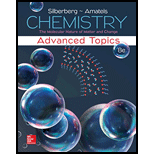
Concept explainers
(a)
Interpretation:
The number of moles and number of ions of each type in
Concept introduction:
Molarity
The expression to calculate the moles of the compound when molarity of solution and volume of solution are given is as follows:
The expression to calculate the moles of ions is as follows:
The expression to calculate the number of ions is as follows:
(a)
Answer to Problem 4.27P
The number of moles of is
Explanation of Solution
The expression to calculate the moles of magnesium chloride is:
The relation between
Substitute
One mole of magnesium chloride
The expression to calculate the amount of
Substitute
The expression to calculate the number of
Substitute
The expression to calculate the amount of
Substitute
The expression to calculate the number of
Substitute
The number of moles of is
(b)
Interpretation:
The number of moles and number of ions of each type in
Concept introduction:
Molarity
The expression to calculate the moles of solute when given mass and molecular mass of compound are given is as follows:
The expression to calculate the moles of ions is as follows:
The expression to calculate the number of ions is as follows:
(b)
Answer to Problem 4.27P
The number of moles of is
Explanation of Solution
The molecular mass of aluminium sulfate
The expression to calculate the moles of aluminium sulfate
Substitute
One mole of aluminium sulfate
The expression to calculate the amount of
Substitute
The expression to calculate the number of
Substitute
The expression to calculate the amount of
Substitute
The expression to calculate the number of
Substitute
The number of moles of is
(c)
Interpretation:
The number of moles and number of ions of each type in
Concept introduction:
A formula unit is used for the ionic compound to represent their empirical formula. The expression to calculate the moles of a compound when the volume of solution and formula unit of a compound is given is as follows:
The expression to calculate the moles of ions is as follows:
The expression to calculate the number of ions is as follows:
(c)
Answer to Problem 4.27P
The number of moles of is
Explanation of Solution
One mole of cesium nitrate
The expression to calculate the moles of
Substitute
The expression to calculate the amount of
Substitute
The expression to calculate the number of
Substitute
The expression to calculate the amount of
Substitute
The expression to calculate the number of
Substitute
The number of moles of is
Want to see more full solutions like this?
Chapter 4 Solutions
Student Solutions Manual For Silberberg Chemistry: The Molecular Nature Of Matter And Change With Advanced Topics
- Identify the compound with the longest carbon - nitrogen bond. O CH3CH2CH=NH O CH3CH2NH2 CH3CH2C=N CH3CH=NCH 3 The length of all the carbon-nitrogen bonds are the samearrow_forwardIdentify any polar covalent bonds in epichlorohydrin with S+ and 8- symbols in the appropriate locations. Choose the correct answer below. Η H's+ 6Η Η Η Η Η Ηδ Η Ο Ο HH +Η Η +Η Η Η -8+ CIarrow_forwardH H:O::::H H H HH H::O:D:D:H HH HH H:O:D:D:H .. HH H:O:D:D:H H H Select the correct Lewis dot structure for the following compound: CH3CH2OHarrow_forward
- Rank the following compounds in order of decreasing boiling point. ннннн -С-С-Н . н-с- ННННН H ΗΤΗ НННН TTTĪ н-с-с-с-с-о-н НННН НН C' Н н-с-с-с-с-н НН || Ш НННН H-C-C-C-C-N-H ННННН IVarrow_forwardRank the following compounds in order of decreasing dipole moment. |>||>||| ||>|||>| |>|||>|| |||>||>| O ||>>||| H F H F H c=c || H c=c F F IIIarrow_forwardchoose the description that best describes the geometry for the following charged species ch3-arrow_forward
- Why isn't the ketone in this compound converted to an acetal or hemiacetal by the alcohol and acid?arrow_forwardWhat is the approximate bond angle around the nitrogen atom? HNH H Harrow_forwardOH 1. NaOCH2CH3 Q 2. CH3CH2Br (1 equiv) H3O+ Select to Draw 1. NaOCH2 CH3 2. CH3Br (1 equiv) heat Select to Edit Select to Drawarrow_forward
- Complete and balance the following half-reaction in acidic solution. Be sure to include the proper phases for all species within the reaction. S₂O₃²⁻(aq) → S₄O₆²⁻(aq)arrow_forwardQ Select to Edit NH3 (CH3)2CHCI (1 equiv) AICI 3 Select to Draw cat. H2SO4 SO3 (1 equiv) HO SOCl2 pyridine Select to Edit >arrow_forwardComplete and balance the following half-reaction in basic solution. Be sure to include the proper phases for all species within the reaction. Zn(s) → Zn(OH)₄²⁻(aq)arrow_forward
 ChemistryChemistryISBN:9781305957404Author:Steven S. Zumdahl, Susan A. Zumdahl, Donald J. DeCostePublisher:Cengage Learning
ChemistryChemistryISBN:9781305957404Author:Steven S. Zumdahl, Susan A. Zumdahl, Donald J. DeCostePublisher:Cengage Learning ChemistryChemistryISBN:9781259911156Author:Raymond Chang Dr., Jason Overby ProfessorPublisher:McGraw-Hill Education
ChemistryChemistryISBN:9781259911156Author:Raymond Chang Dr., Jason Overby ProfessorPublisher:McGraw-Hill Education Principles of Instrumental AnalysisChemistryISBN:9781305577213Author:Douglas A. Skoog, F. James Holler, Stanley R. CrouchPublisher:Cengage Learning
Principles of Instrumental AnalysisChemistryISBN:9781305577213Author:Douglas A. Skoog, F. James Holler, Stanley R. CrouchPublisher:Cengage Learning Organic ChemistryChemistryISBN:9780078021558Author:Janice Gorzynski Smith Dr.Publisher:McGraw-Hill Education
Organic ChemistryChemistryISBN:9780078021558Author:Janice Gorzynski Smith Dr.Publisher:McGraw-Hill Education Chemistry: Principles and ReactionsChemistryISBN:9781305079373Author:William L. Masterton, Cecile N. HurleyPublisher:Cengage Learning
Chemistry: Principles and ReactionsChemistryISBN:9781305079373Author:William L. Masterton, Cecile N. HurleyPublisher:Cengage Learning Elementary Principles of Chemical Processes, Bind...ChemistryISBN:9781118431221Author:Richard M. Felder, Ronald W. Rousseau, Lisa G. BullardPublisher:WILEY
Elementary Principles of Chemical Processes, Bind...ChemistryISBN:9781118431221Author:Richard M. Felder, Ronald W. Rousseau, Lisa G. BullardPublisher:WILEY





